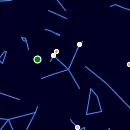Asteroid 2 Pallas Observation Details

Pallas Daily Motion
Pallas will reach its transit before twilight, at 13:56. By the onset of twilight at 16:22, it will be at elevation, and it will set before sunrise, at 19:45.2 Pallas will be visible until December, 31, when it will move too close to the Sun. During this time, its proximity to the Sun will cause it to disappear from the night sky, making it unobservable for a while.
Pallas Visibility Timetable on December 08
Pallas Rise and Set Timetable
| Time | Elevation | |
| Pallas transit | 13:56 | 49° |
| Sunset | 14:48 | 47° |
| Civil sunset | 15:18 | 45° |
| Astrosession begin | 16:22 | 37° |
| Moon Rise, 85.7% illuminated | 17:57 | 21° |
| Pallas set | 19:45 | |
| Astrosession end | 03:36 | -49° |
| Pallas rise | 08:06 | |
| Moon Set | 08:54 | 10° |
Track Pallas Position Throughout the Night
← Mon, 8 December 2025 →
| Time | |
| Altitude | |
| Azimuth |
Shift the map to change the time and observe Pallas changing position in the night sky.
Pallas Description
Pallas, designated as 2 Pallas, is a main-belt asteroid, located between Mars and Jupiter in the solar system. With a diameter of 514 km, 2 Pallas completes its orbit around the Sun in 4.6 years. At the moment, 2 Pallas is 3.695 AU (552,764,132 km) from Earth, and it is located in the constellation Aquarius.Current position of Pallas in Solar System
| Date | Mon, 8 December 2025 |
| Distance from Earth to Pallas | 3.699 AU (553,362,524km) |
| Elongation | 61° |
| Angular diameter | " |
| Magnitude | 10.44 |
Finder Chart for Pallas
Double-click to unlock the map.
| Object name | 2 Pallas |
| Field of view | |
| Limiting magnitude | |
| 2 Pallas coordinates | 20.945579353096, -3.5731788598714 |
| Center coordinates | 20.945579353096, -3.5731788598714 |
Annual motion of Pallas
| Date | Mon, 8 December 2025 |
| Twighlight start | 16:18 |
| Twighlight end | 03:30 |
| Twighlight duration | 11h 11m |
| Rise | 08:05 |
| Set | 19:41 |
| Elevation at transit | 49° |
| Transit time | 13:53 |
| Equatorial coordinates | RA: 20h 57m 48s", Dec: -3° 36' 49s |
| Magnitude | 10 |
| Constellation | Aquarius |
The graph illustrates the annual visibility pattern of a Pallas, providing a comprehensive overview of its daily appearances and transit times throughout the year.
The graph is structured with the vertical axis showing the hours of the day, ranging from 12 AM to 12 AM the next day, while the horizontal axis spans each day of the year.
The reddish shaded area indicates the periods when the Pallas is above the horizon, visible to observers. The white line marks the times when the celestial object reaches its highest point in the sky each day, known as the transit.
The graph is structured with the vertical axis showing the hours of the day, ranging from 12 AM to 12 AM the next day, while the horizontal axis spans each day of the year.
The reddish shaded area indicates the periods when the Pallas is above the horizon, visible to observers. The white line marks the times when the celestial object reaches its highest point in the sky each day, known as the transit.
Astrometric & Physical Parameters of 2 Pallas
Coordinates & Visibility
| Right Ascension | 20.945579353096° |
| Declination | -3.5731788598714° |
| Magnitude | 10.44 |
| Constellation | Aquarius |
| Elevation | -9.7° |
| Azimuth | -87.1° |
Physical properties
| Mean radius in kilometres | 545 |
| Boby mass in kg | 2.11E+20 |
| Body density in g.cm3 | 1 |
Orbital Parameters
| Sideral orbital time for body around another one (the Sun or a planet) in earth day | 1685.927 |
Data Acknowledgment
Our solar system data—including planetary physical and orbital parameters—comes from the Solar System OpenData API , maintained by Le Système Solaire. We thank Christophe and the contributors for making this open data available.
Acknowledgments
We acknowledge NASA's Jet Propulsion Laboratory (JPL) for providing essential data on asteroids and comets through their Small-Body Database (SBDB) and Center for Near-Earth Object Studies (CNEOS). Their continuous efforts in tracking and cataloging these celestial bodies make it possible to offer accurate and up-to-date information on their positions, orbits, and physical characteristics.
